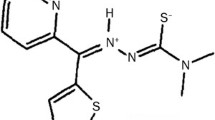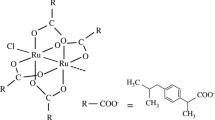Abstract
Background: Taurolidine, a derivative of the amino acid taurine, exhibits antiendotoxin, antibacterial, and antiadherence activity. We hypothesized that Taurolidine may inhibit tumor cell growth, both in an in vitro and in vivo setting. Our aim was to examine the effect of Taurolidine on the growth of a rat metastatic colorectal tumor cell line (DHD/K12/TRb) in vitro and in vivo.
Methods: In the in vitro experiments, DHD/K12/TRb cells were incubated with 5, 10, 15, 25 μg/ml of Taurolidine. Cells incubated in culture medium alone were used as controls. Cell proliferation, cell viability, cell death, and cell apoptosis were measured using commercially available techniques. In the in vivo experiment, BD IX rats were randomized into two groups (n = 10/group). Group A (control) underwent laparotomy and instillation of DHD/K12/TRb tumor cells intraperitoneally followed by phosphate buffered saline (PBS). Group B received Taurolidine (100 mg/kg) instead of PBS. Animals were killed after 24 days and tumor burden assessed by counting the number of tumor nodules in the peritoneal cavity.
Results: Incubation of the tumor cells with Taurolidine resulted in a 4-fold decrease in proliferation rates (25 ± 4% vs. 100 ± 28% for controls) and a 4-fold increase in cell necrosis as demonstrated by the increase in LDH release (403 ± 28% vs. 100 ± 26% for controls), at a Taurolidine concentration of 25 μg/ml. A dose-dependent decrease in cell viability was also observed. In the in vivo study, local Taurolidine administration resulted in significant decreases in tumor burden (3 ± 1 nodules in Group B animals vs. 649 ± 101 nodules in Group A animals).
Conclusions: Taurolidine inhibits the growth of a rat metastatic colorectal tumor cell line in vitro and in vivo and thus may have potential in the prevention of peritoneal metastases.
Similar content being viewed by others
References
Hewett PJ, Texler ML, Anderson D, King G, Chatterton BE. In vivo real-time analysis of intraperitoneal radiolabeled tumor cell movement during laparoscopy. Dis Colon Rectum 1999;42:868–875.
Cintron JR, Pearl RK. Colorectal cancer and peritoneal carcinomatosis. Semin Surg Oncol 1996;12:267–278.
Elias D, Antoun S, Raynard B, Puizillout JM, Sabourin JC, Ducreux M, Lasser P. Treatment of peritoneal carcinomatosis using complete excision and intraperitoneal chemohyperthermia. A phase I-II study defining the best technical procedures. Chirurgie 1999;124:380–389.
Sugarbaker PH. Successful management of microscopic residual disease in large bowel cancer. Cancer Chemother Pharmacol 1999;43(suppl):S15–S25.
Da Costa M, Redmond P, Bouchier-Hayes DJ. The effect of laparotomy and laparoscopy on the establishment of spontaneous tumor metastases. Surgery 1998;24:516–525.
Ayala A, Deol ZK, Lehman DL, Herdon CD, Chaudry IH. Does endotoxin play a major role in inducing the depression of macrophage function during polymicrobial sepsis? Arch Surg 1995;130:1178–1184.
Marsh CB, Wewers MD. The pathogenesis of sepsis. Factors that modulate the response to gram negative bacterial infection. Clin Chest Med 1996;17:183–197.
Jacob AI, Goldberg PK, Bloom M, Degenshein A, Kozinn PJ. Endotoxin and bacteria in portal blood. Gastroenterology 1977;72:1268–1270.
Pidgeon GP, Harmey JH, Kay E, Da Costa M, Redmond HP, Bouchier-Hayes DJ. The role of endotoxin/lipopolysaccharide in surgically induced tumor growth in a murine model of metastatic disease. Br J. Cancer 1999;81:1311–1317.
Myers A, Allwood MC. The interaction between taurolin and endotoxin. Microbios Lett 1980;13:141–144.
Browne MK, Leslie GB, Pfirrmann RW. The in vitro and in vivo activity of Taurolin against anaerobic pathogenic organisms. Surg Gynecol Obstet 1977;145:842–846.
Traub WH, Leonhard B, Bauer D. Taurolidine: in vitro activity against multiple-antibiotic-resistant, nosocomally significant clinical isolates of Staphlococcus aureus, Enterococcus faecium, and diverse Enterobacteriaceae. Chemotherapy 1993;39:322–330.
Gorman SP, McCafferty DF, Woolfson AD, Jones DS. Reduced adherence of micro-organisms to human mucosal epithelial cells following treatment with Taurolin, a novel antimicrobial agent. J Appl Bacteriol 1987;62:315–320.
Staubach KH. Adjuvant therapy of peritonitis with taurolidine. Modulation of mediator liberation. Langenbecks Arch Chir 1997;382(4 suppl 1):S26–S30.
Baker DM, Jones JA, Nygen-Van-Tam JS, et al. Taurolidine peritoneal lavage as prophylaxis against infection after elective colorectal surgery. Br J Surg 1994;81:1054–6.
Willatts SM, Radford S, Leitermann M. Effect of the antiendotoxin agent, taurolidine, in the treatment of sepsis syndrome: a placebocontrolled, double-blind trial. Crit Care Med 1995;23:1033–1039.
Martin MS, Bastein H, Martin F, Michiels R, Martin MR, Justrabo E. Transplantation of intestinal carcinoma in inbred rats. Biomedicine 1973;19:555–558.
Dunnington D, Burscarino C, Gennaro D, Greig R, Poste G. Characterization of an animal model of metastatic colon carcinoma. Int Cancer 1987;39:248–254.
Pauli BU, Augustin-Voss HG, el-Sabban ME, Johnson RC, Hammer DA. Organ-preference of metastasis. The role of endothelial cell adhesion molecules. Cancer Metastasis Rev 1990;9:175–189.
Gutman M, Fidler IJ. Biology of human colon cancer metastasis. World J Surg 1995;19:226–234.
van den Tol PM, van Rossen EE, van Eijck CH, Bonthuis F, Marquet RL, Jeekel H. Reduction of peritoneal trauma by using nonsurgical gauze leads to less implantation metastasis of spilled tumor cells. Ann Surg 1998;227:242–248.
Jacobi CA, Ordemann J, Bohm B, Zieren H, Sabat R, Muller J. Inhibition of tumour cell growth and implantation in laparoscopic surgery in a rat model. Am J Surg 1997;174:359–363.
Redmond HP, Leahy AL, Carey JA, Darzi A, Maxwell B, Keane FBV, Tanner WA. Beneficial effects of Taurolidine in experimental pancreatitis. J Surg Res 1994;56:256–260.
Rosman R, Westerveld GJ, van Oeveren W, Kooi K, Bleichrodt RP. Effect of intraperitoneal antimicrobials on the concentration of bacteria, endotoxin, and tumor necrosis factor in abdominal fluid and plasma in rats. Eur Surg Res 1996;28:351–360.
Author information
Authors and Affiliations
Corresponding author
Rights and permissions
About this article
Cite this article
McCourt, M., Wang, J.H., Sookhai, S. et al. Taurolidine Inhibits Tumor Cell Growth In Vitro and In Vivo. Ann Surg Oncol 7, 685–691 (2000). https://doi.org/10.1007/s10434-000-0685-6
Received:
Accepted:
Issue Date:
DOI: https://doi.org/10.1007/s10434-000-0685-6




